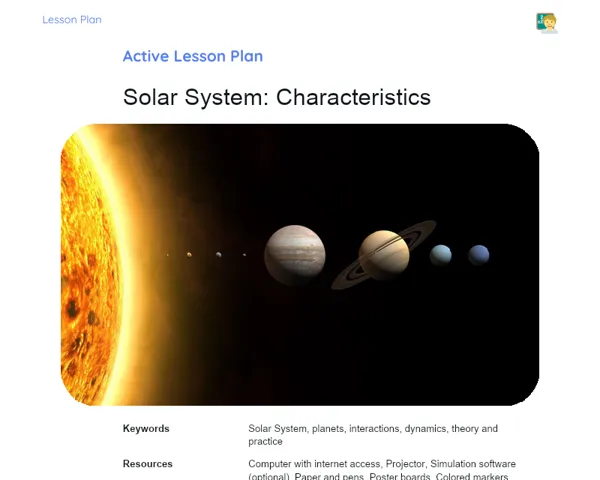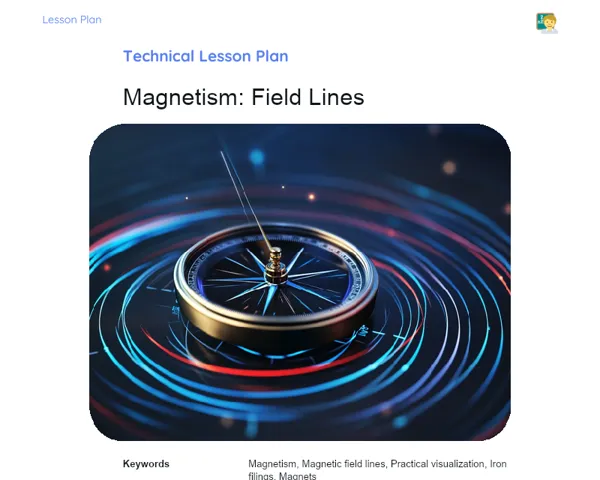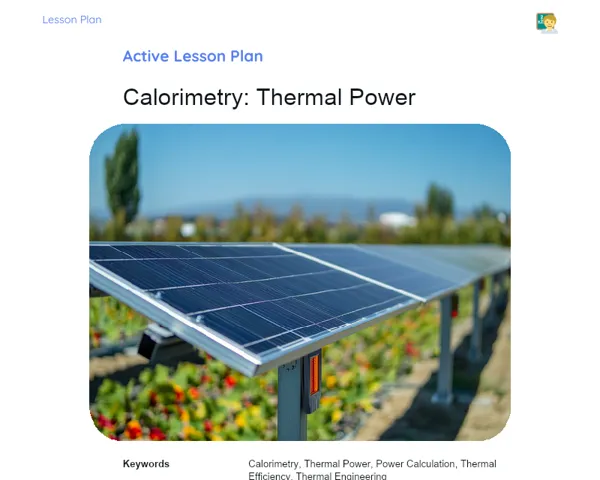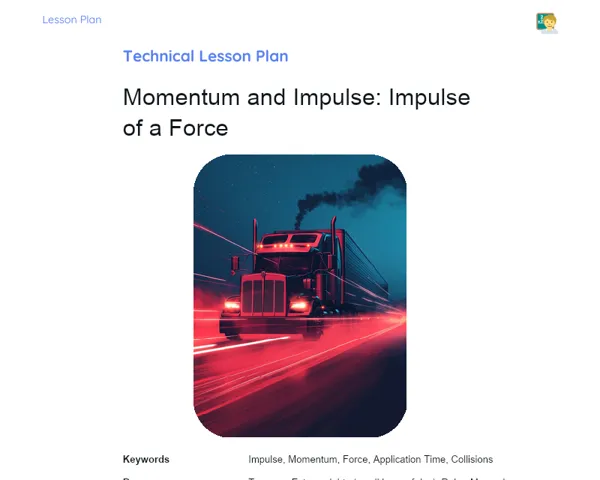Lesson Plan | Lesson Plan Tradisional | Kinematics: Average Vector Velocity
| Keywords | Kinematics, Average Vector Velocity, Average Scalar Velocity, Vector Displacement, Time Interval, Calculating Average Vector Velocity, Practical Examples, Problem Solving, Difference Between Vector and Scalar Velocity, Everyday Applications |
| Resources | Whiteboard and markers, Projector or presentation slides, Calculators, Paper and pens for taking notes, Exercise sheets with average vector velocity problems, Ruler or measuring tape (for demonstration if needed) |
Objectives
Duration: (10 - 15 minutes)
The purpose of this stage is to introduce students to key concepts that will be explored during the lesson, building a solid foundation for understanding the nuances between average vector velocity and average scalar velocity. This understanding is critical to ensure that students appreciate the significance and practical applications of these concepts in physics as well as in everyday scenarios.
Objectives Utama:
1. Differentiate between average vector velocity and average scalar velocity.
2. Calculate average vector velocity as the change in position divided by time.
Introduction
Duration: (10 - 15 minutes)
🎯 Purpose: The purpose of this stage is to introduce students to the main concepts that will be discussed during the lesson, creating a robust foundation for distinguishing between average vector velocity and average scalar velocity, as well as learning to calculate average vector velocity. This foundational knowledge will help students understand the importance and real-world applications of these concepts in both physics and daily life.
Did you know?
🎢 Curiosity: Did you know that average vector velocity plays a crucial role in aviation navigation? Airline pilots must factor in not only the speed and direction of their aircraft but also additional elements like wind speed and direction to chart the most efficient course. A small error in calculating vector velocity can result in considerable deviations, impacting flight duration and fuel efficiency.
Contextualization
🗺️ Context: To kick off the class, explain to students that Kinematics is the branch of Physics concerned with the motion of objects, without diving into what causes that motion. Specifically, average vector velocity is an important concept that enables the analysis of how an object's position changes over time, taking direction into account. In contrast to average scalar velocity, which only considers magnitude, average vector velocity incorporates both magnitude and direction, thus providing a more thorough understanding of motion.
Concepts
Duration: (45 - 55 minutes)
🎯 Purpose: The aim of this segment is to deepen students' understanding of the core principles of average vector velocity, distinguishing it from average scalar velocity and enabling students to accurately calculate average vector velocity. Through a mix of theoretical explanations, practical examples, and problem-solving exercises, the objective is to ensure comprehensive mastery of the discussed topic.
Relevant Topics
1. 📌 Vector Displacement: Explain that vector displacement is the change in position of an object, factoring in both magnitude and direction. Stress that it is a vector quantity and should not be confused with distance traveled, which is scalar in nature.
2. 📌 Time and Time Interval: Emphasize that time is crucial for measuring the duration of events. The time interval represents the difference between two specific points in time, indicating the duration of an event or displacement.
3. 📌 Average Vector Velocity: Indicate that average vector velocity is defined as vector displacement divided by the time interval. Highlight that, unlike average scalar velocity, average vector velocity considers the direction of motion.
4. 📌 Difference Between Average Scalar Velocity and Average Vector Velocity: Clarify that average scalar velocity is the ratio of total distance traveled to total time, while average vector velocity takes into account both displacement and direction. Provide practical examples to illustrate the difference.
5. 📌 Calculating Average Vector Velocity: Show how to calculate average vector velocity using the formula: v = Δr/Δt, where Δr symbolizes vector displacement and Δt denotes the time interval. Solve numerical examples to cement the concept.
To Reinforce Learning
1. 1️⃣ A car covers 100 km north and then 50 km south in 3 hours. What is the car's average vector velocity?
2. 2️⃣ A cyclist rides 30 km east in 2 hours and then 40 km west in 3 hours. Calculate the cyclist's average vector velocity.
3. 3️⃣ An airplane flies 500 km north in 2 hours and then 300 km east in 1 hour. What is the average vector velocity of the airplane?
Feedback
Duration: (20 - 25 minutes)
🎯 Purpose: The purpose of this section is to reinforce the knowledge acquired by students through an in-depth discussion of the proposed questions, allowing for reflection and engagement. This ensures students develop a thorough understanding of average vector velocity concepts and how to employ them in both real-world and theoretical scenarios.
Diskusi Concepts
1. 1️⃣ A car covers 100 km north and then 50 km south in 3 hours. What is the car's average vector velocity?
Explanation: The total vector displacement is the difference between the distances traveled north and south, meaning 100 km - 50 km = 50 km north. The time interval is 3 hours. Hence, the average vector velocity is given by v = Δr/Δt = 50 km / 3 h ≈ 16.67 km/h north. 2. 2️⃣ A cyclist rides 30 km east in 2 hours and then 40 km west in 3 hours. Calculate the cyclist's average vector velocity.
Explanation: The total vector displacement is derived from the difference between travels east and west, so 30 km - 40 km = -10 km (or 10 km west). The time interval amounts to 2 h + 3 h = 5 hours. Thus, the average vector velocity is calculated as v = Δr/Δt = -10 km / 5 h = -2 km/h (2 km/h west). 3. 3️⃣ An airplane travels 500 km north in 2 hours and then 300 km east in 1 hour. What is the average vector velocity of the airplane?
Explanation: To compute the average vector velocity in this instance, it is crucial to consider the directional vector components of displacement. The overall displacement in 3 hours is the vector sum of the northward and eastward travels. Using the average vector velocity formula and applying the Pythagorean theorem to find the resultant vector's magnitude, we calculate: Δr = √(500² + 300²) km = √(250000 + 90000) km ≈ 583 km. The time interval is 3 hours, so the average vector velocity is v = Δr/Δt = 583 km / 3 h ≈ 194.33 km/h.
Engaging Students
1. 🔍 Question 1: How would the average vector velocity change if the car in the first example traveled 50 km south first and then 100 km north? Would the result differ? 2. 🔍 Question 2: In the second example, what impact would the average vector velocity face if the cyclist had made the reverse trip (first 40 km west and then 30 km east)? 3. 🔍 Question 3: How does considering vector components affect the calculation of average vector velocity in the third case? Why is it crucial to factor in direction? 4. 💡 Reflection 1: In what ways could understanding average vector velocity be beneficial in daily activities like trip planning or choosing the best route using navigation apps? 5. 💡 Reflection 2: Why is differentiating between average vector velocity and average scalar velocity important in contexts such as sports, transportation, and engineering?
Conclusion
Duration: (10 - 15 minutes)
🎯 Purpose: The aim of this concluding segment is to summarize and reinforce the crucial concepts discussed throughout the lesson, ensuring students have a clear and robust understanding of the content presented. Additionally, it seeks to tie theory to practical applications and shed light on how this topic is relevant to students’ daily lives, cementing their learning in a meaningful manner.
Summary
['📌 Kinematics: The study of object motion without diving into its causes.', "📌 Average Vector Velocity: The change in an object's position over time while considering direction.", '📌 Average Scalar Velocity: The ratio of total distance covered to total time spent.', '📌 Difference Between Average Vector Velocity and Average Scalar Velocity: The former accounts for direction, while the latter does not.', '📌 Calculating Average Vector Velocity: Using the formula v = Δr/Δt.']
Connection
The lesson effectively bridged theory with practice by employing concrete examples—such as the motion of a car, cyclist, and airplane—to illustrate how average vector velocity is calculated and utilized. These cases underscored the importance of considering the direction of motion in analyzing average vector velocity, distinguishing it from average scalar velocity, and showcasing its relevance in real-world contexts like navigation and transportation.
Theme Relevance
Grasping the concept of average vector velocity is vital for many everyday scenarios, be it in planning travel routes, optimizing directions on navigation applications, or even in sports and engineering practices. For instance, airline pilots leverage this concept to adjust flight paths according to wind conditions, guaranteeing a more efficient and safer journey. Understanding this difference can enhance decision-making and lead to better resource allocation.



